Beef bacon is a flavorful alternative to traditional pork bacon, made from high-quality cuts of beef such as brisket, chuck, or round. Unlike pork bacon, which is often fatty, beef bacon tends to be leaner but still packs a rich, smoky flavor that appeals to many.
Its rise in popularity can be attributed to several factors. For those on halal, kosher, or pork-free diets, beef bacon provides a delicious way to enjoy bacon-like flavor without violating dietary restrictions. Additionally, the taste of beef bacon is distinct, offering a heartier, more meaty profile compared to its pork counterpart.
Today, beef bacon isn’t just a substitute—it’s a sought-after ingredient in dishes like gourmet burgers, breakfast platters, and even innovative desserts. Its versatility and bold flavor show that culinary creativity is thriving and catering to diverse tastes.
The History Behind Beef Bacon
This savory alternative has historical roots in various cultural traditions, especially in regions where pork consumption was restricted due to religious practices. Communities such as Muslims and Jews sought an alternative to pork-based products, and over time, curing beef became a practical and flavorful solution. For example, those interested in halal chicken options may find similar cultural and dietary considerations inspiring the rise of this product.
The practice of preserving meat through salting and smoking dates back thousands of years. Ancient civilizations, for example, used these methods to extend the shelf life of meats like beef, which laid the foundation for what we now know as this popular product. For a deeper dive into high-quality beef products, check out our guide on lean ground beef.
In the mid-20th century, this alternative began to appear in Western markets, particularly in areas with limited pork consumption. As globalization brought different cuisines to the forefront, this bacon-style product gained recognition not just as a substitute but as a delicacy in its own right, celebrated for its deep history and robust flavor.
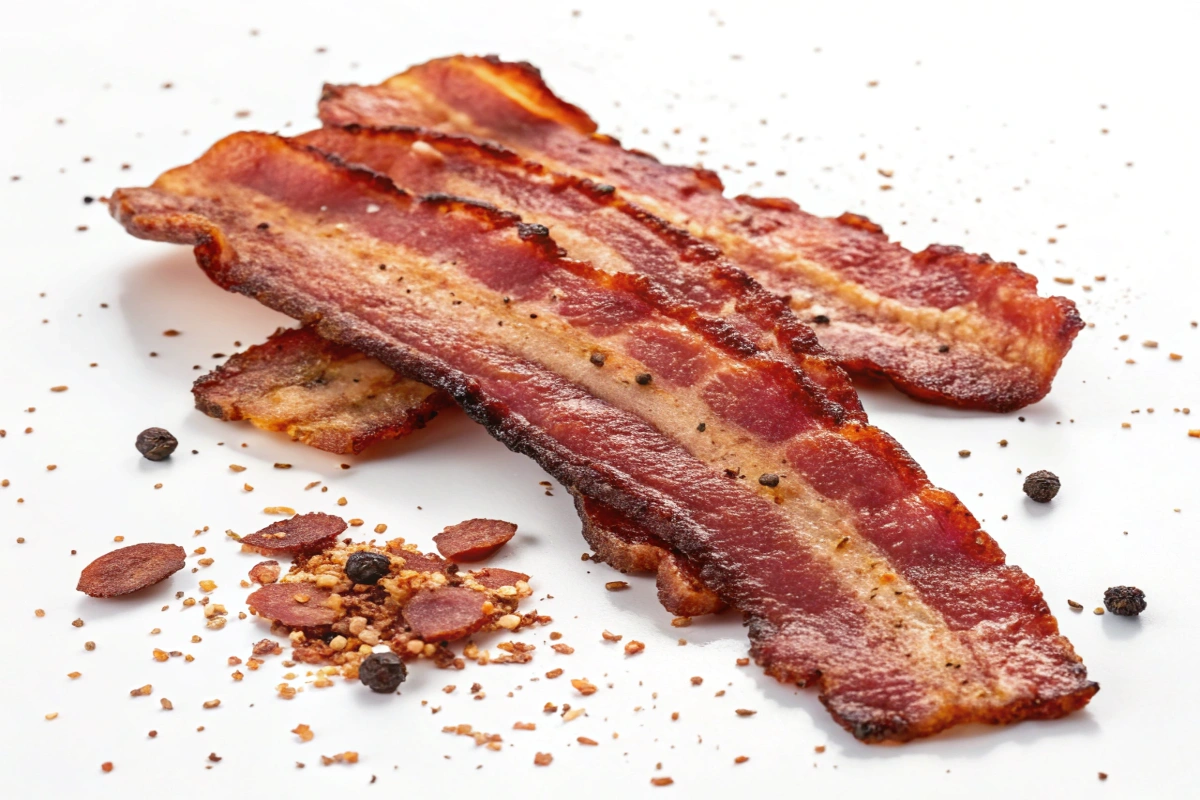
How It’s Made: The Process
Creating this bacon-style product combines traditional methods with modern innovation, blending artistry and precision. Here’s how producers achieve its smoky and savory profile:
Choosing the Right Cuts
The process begins with selecting the ideal cuts of beef. Some of the most popular options include:
- Brisket: Known for its rich marbling and tenderness.
- Chuck: Offers a balanced ratio of lean meat and fat.
- Round: A leaner cut, ideal for those seeking a healthier option.
For those interested in exploring more beef recipes, our beef and tomatoes guide provides a perfect example of creative ways to enjoy this versatile ingredient. Producers carefully trim these cuts to balance fat and meat, ensuring a texture and flavor that appeals to diverse palates.
Curing the Meat
Curing plays a crucial role in creating the characteristic taste of this product. The meat is seasoned with a blend of salt, sugar, and spices to enhance its flavor while preserving it for longer storage. Traditional methods involve dry rubbing the beef and allowing it to rest for several days. In contrast, some modern producers use brine injection to speed up the process. Both approaches help develop a solid foundation for the smoky flavor.
If you’re curious about other beef-based creations, don’t miss our article on beef chips for another delicious twist on this versatile meat.
Smoking the Bacon
After curing, the next step is smoking, which imparts the signature smoky aroma and taste. Producers use hardwoods like hickory, applewood, or cherry to create unique flavor profiles. The process is carefully controlled to ensure the meat cooks evenly while retaining its natural moisture, resulting in a rich and satisfying taste.
Slicing and Packaging
Once smoked, the beef is sliced into strips. Producers adjust the thickness based on consumer preferences—thin slices are ideal for quick frying, while thicker cuts provide a heartier bite. Finally, the bacon is vacuum-sealed to lock in freshness and flavor, ensuring it stays delicious until it reaches the consumer’s kitchen.
The Nutritional Profile of Beef Bacon
This savory bacon-style alternative isn’t just delicious—it also boasts a unique nutritional profile that sets it apart from pork-based options. Let’s break down why it’s an excellent choice for health-conscious individuals.
Calories and Fat Content
Generally, this option is leaner than its pork counterpart, depending on the cut. It typically contains fewer calories per serving, making it a smarter choice for those managing their calorie intake. Additionally, its lower saturated fat content offers benefits for heart health. If you’re looking for leaner protein options, explore our guide on lean ground beef for other healthier choices.
Protein Powerhouse
As a beef-based product, it’s packed with protein. For instance, a single serving can deliver up to 10 grams of protein, providing an excellent energy source and helping to keep you full longer. For those who love protein-rich breakfasts, consider recipes like venison breakfast sausage for variety.
Vitamins and Minerals
This alternative is also a rich source of essential nutrients, including:
- Iron: Vital for producing healthy red blood cells.
- Zinc: Supports immune function and promotes cell repair.
- B Vitamins: Crucial for metabolism and brain health.
Comparison with Pork Bacon
While pork-based options are higher in fat and calories, they also contain more omega-3 fatty acids. However, the lower saturated fat and higher protein content found in this alternative make it a healthier option for many people. Those on keto or paleo diets will appreciate its high protein and low carbohydrate content, which fits perfectly into these eating plans. If you’re interested in pairing it with low-calorie dishes, try our low-calorie skinny margarita recipe for a guilt-free treat.
By understanding its nutritional benefits, consumers can make informed decisions about adding this product to their meals. If you’re looking for more ideas, explore recipes like beef and tomatoes to incorporate nutritious beef-based dishes into your diet.
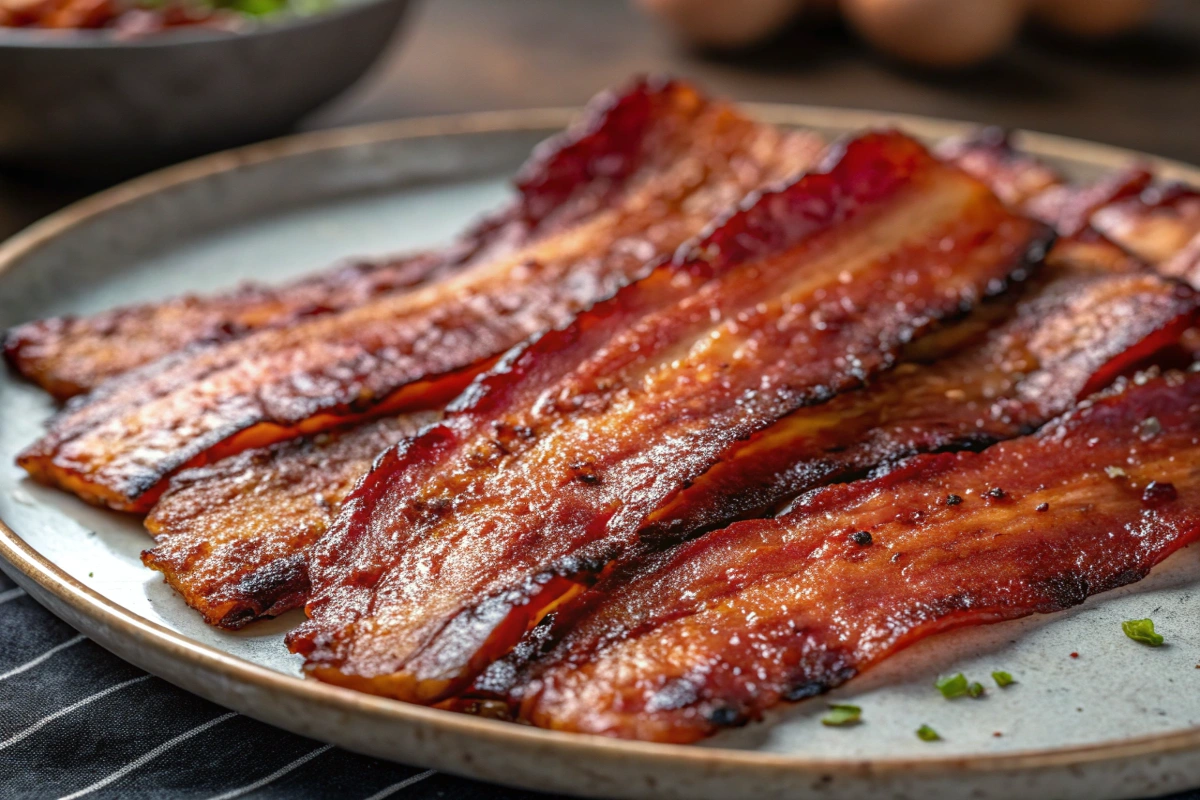
Health Benefits of This Bacon Alternative
When eaten in moderation, this bacon-style option offers several health benefits. Here’s why many consider it a better choice:
Lower in Saturated Fat
Made from leaner cuts, this option contains less saturated fat compared to pork-based products. As a result, it’s a heart-healthier choice that doesn’t sacrifice flavor
High in Protein
Its high protein content makes it an excellent addition to meals, especially for those seeking an energy boost. Protein plays a critical role in muscle repair and helps maintain satiety for longer periods.
Rich in Essential Nutrients
Packed with vital nutrients like iron, zinc, and B vitamins, this product supports various health functions. These nutrients boost the immune system, promote energy production, and contribute to overall well-being.
Catering to Dietary Preferences
This pork-free option aligns with dietary preferences such as halal, kosher, or low-carb diets. Its versatility makes it a great fit for a wide range of lifestyles and preferences.r a wide range of dietary restrictions, including halal and kosher diets, offering a bacon-like experience to people who can’t consume pork. This versatility makes it accessible to more individuals.
Understanding the Taste and Texture of Beef Bacon
This bacon-style alternative offers a flavor and texture that truly set it apart from traditional pork options. Its taste is rich, smoky, and slightly beefier, often described as heartier and more robust. As a result, it works exceptionally well in recipes requiring bold flavors, such as gourmet burgers or savory breakfast dishes.
In terms of texture, this alternative tends to be firmer, delivering a satisfying chew. Crispy edges paired with a tender interior create the perfect balance between crunch and softness, making it a versatile addition to countless dishes.
A Global Favorite in Different Cuisines
Thanks to its versatility, this savory ingredient has found a place in various global cuisines. Here’s how it’s enjoyed around the world:
- Middle Eastern Cuisine: Often paired with flatbreads, eggs, or wrapped in savory dishes.
- American Cuisine: A go-to ingredient for burgers, BLTs, and as a topping for pizzas or salads.
- Asian Fusion: Frequently added to noodle dishes or combined with spicy marinades to create bold, flavorful meals.
This adaptability demonstrates how it elevates diverse dishes and caters to an array of taste preferences.
Cooking Techniques for Every Occasion
Preparing this bacon-style product is straightforward, but the right techniques can help you achieve the best results. Below are the most popular methods:
Pan-Frying
Pan-frying offers a quick and easy way to prepare this savory treat. Simply heat a non-stick pan over medium heat, add the slices, and cook until crispy, flipping occasionally to ensure even browning.
Grilling
Grilling adds an extra smoky layer of flavor. Place the strips on a preheated grill and cook them for about 2-3 minutes per side, or until they reach your preferred crispiness level.
Baking
For a less greasy option, baking is a great choice. Lay the slices on a lined baking sheet and bake them at 375°F (190°C) for 15-20 minutes. Flip them halfway through to ensure even crisping.
Incorporating into Recipes
This versatile ingredient can enhance a variety of dishes, including:
- Breakfast Favorites: Scrambled eggs or hearty breakfast burritos.
- Lunch Options: BLTs or Caesar salads with a smoky twist.
- Dinner Ideas: As a pizza topping or to infuse a smoky depth into stews.
By experimenting with different cooking techniques, you can unlock the full potential of this flavorful addition to your meals.ety of meals.
Tips for Buying High-Quality Beef Bacon
Not all beef bacon is equal in quality. Here’s how to make the best choice when shopping:
- Freshness: Select beef bacon with a bright color and a fresh, meaty aroma.
- Marbling: Choose well-marbled slices to enhance flavor and tenderness.
- Labels and Certifications: Look for products labeled as halal, kosher, or organic if they suit your preferences.
- Reputable Brands: Research producers known for their quality and ethical practices.
By paying attention to these factors, you can confidently purchase top-quality beef bacon for your meals.
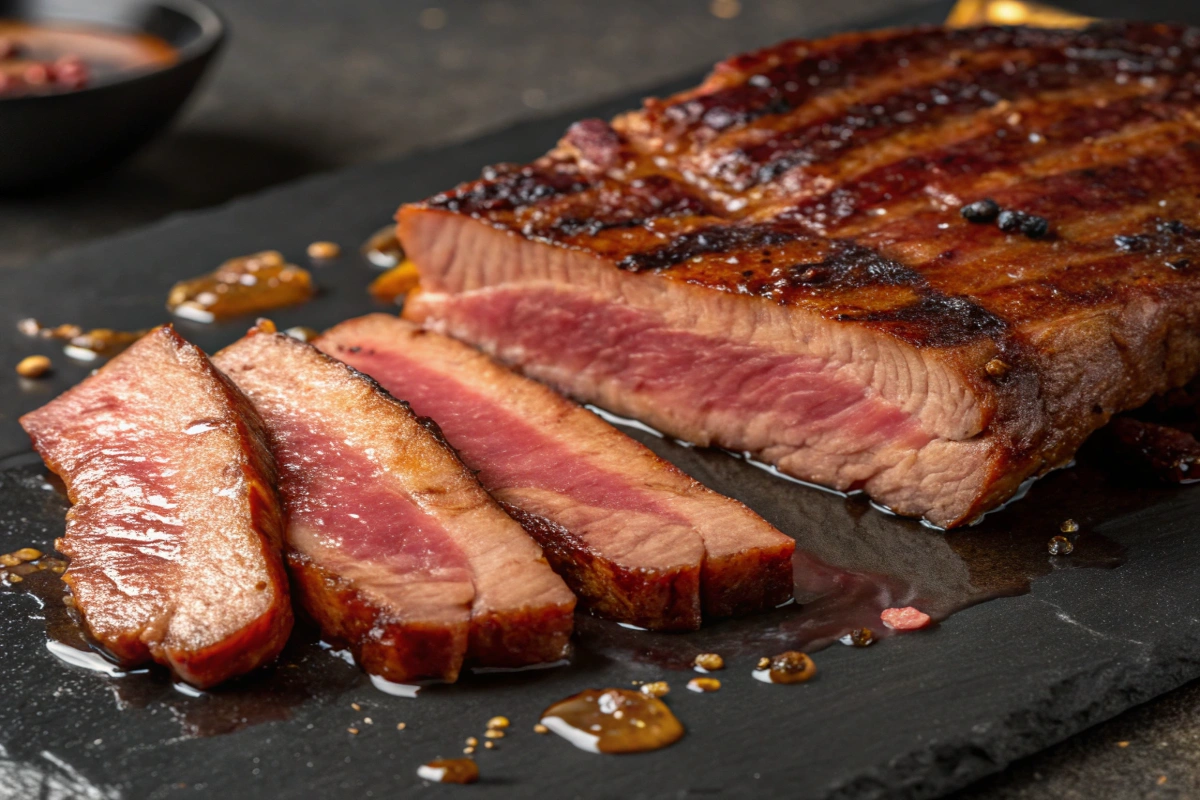
How to Store and Preserve Beef Bacon
Proper storage plays a key role in maintaining the quality of beef bacon. Follow these steps to keep it fresh and flavorful:
- Refrigeration: Store unopened beef bacon in the refrigerator for up to two weeks. After opening, consume it within 5–7 days.
- Freezing: Freeze beef bacon for long-term storage by wrapping individual portions in freezer-safe bags. It can last up to six months in the freezer.
- Thawing: Defrost frozen beef bacon in the refrigerator overnight before cooking.
By storing it correctly, you can enjoy beef bacon at its best whenever you’re ready to cook.
Is Beef Bacon Halal? Exploring Religious and Cultural Perspectives
Many producers prepare beef bacon with halal or kosher certifications to meet religious dietary requirements. These certifications ensure that producers handle and process the meat according to strict guidelines. Consequently, beef bacon becomes a reliable option for individuals with specific dietary needs. Moreover, it has become a staple for Muslim and Jewish communities, as well as for others seeking pork-free alternatives.
Understanding the cultural importance of beef bacon emphasizes its role as a bridge between tradition and modern culinary practices. Additionally, it demonstrates how food can unite people from diverse backgrounds and dietary preferences.
Sustainable Practices in Beef Bacon Production
As sustainability becomes increasingly important, producers focus on eco-friendly practices for beef bacon. For example, many choose ethical sourcing by raising grass-fed or free-range cattle. Additionally, they aim to minimize waste by utilizing every part of the beef during production. Furthermore, producers reduce their carbon footprint by implementing energy-efficient smoking and curing methods.
Consumers can actively support sustainability by choosing brands that prioritize these practices. By doing so, they not only enjoy beef bacon but also contribute to a healthier planet.
Common Myths and Misconceptions About Beef Bacon
Despite its growing popularity, many people often misunderstand beef bacon. Let’s address and debunk some common myths:
- Myth 1: “Beef bacon isn’t as tasty as pork bacon.”
Fact: Beef bacon delivers a unique and delicious flavor profile that many find equally satisfying. - Myth 2: “It’s not a healthy option.”
Fact: With its lower saturated fat content and higher protein levels, beef bacon offers a healthier alternative for many diets. - Myth 3: “It’s difficult to cook.”
Fact: You can easily prepare beef bacon using the right techniques. Whether pan-frying, grilling, or baking, it adapts well to various cooking methods.
By dispelling these misconceptions, more people can appreciate the benefits and versatility of beef bacon. Addressing these myths helps everyone understand what this delicious option has to offer.
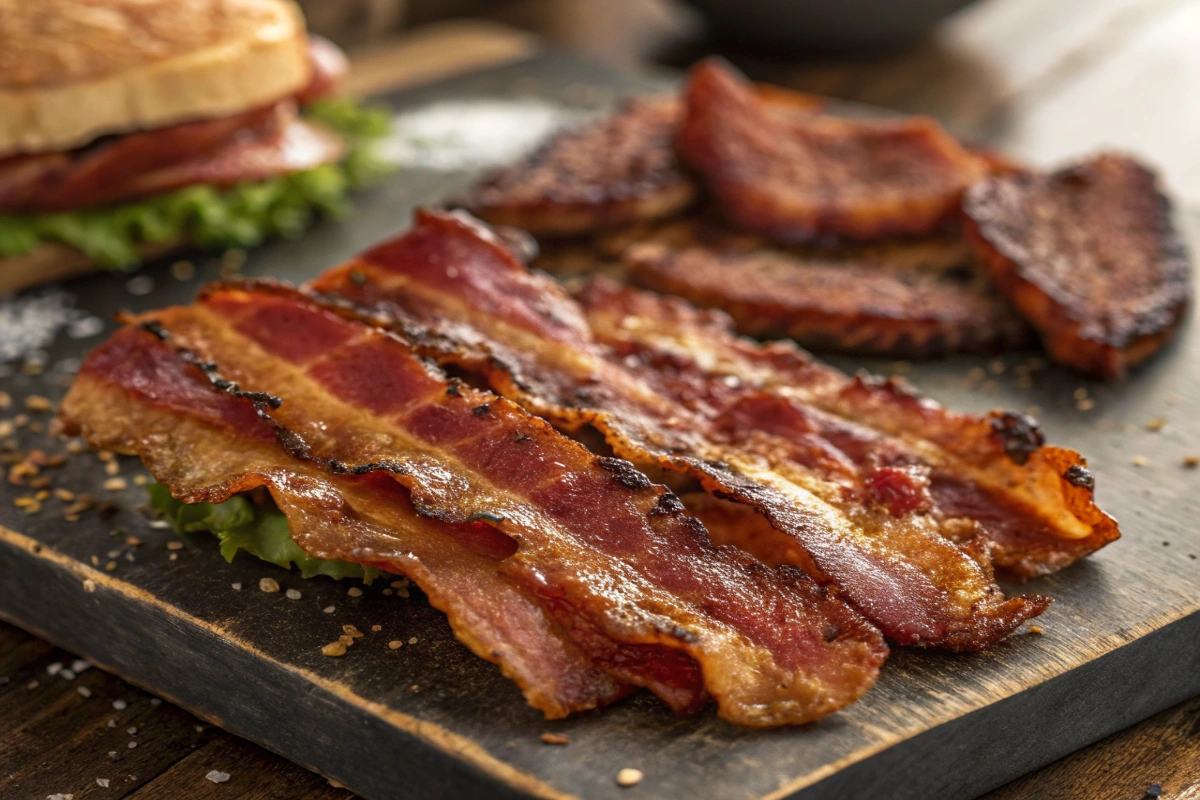
FAQs About Beef Bacon
- How does it differ from regular bacon?
- This bacon alternative is made from beef cuts like brisket or round, whereas regular bacon comes from pork belly. It has a firmer texture and a richer, smokier flavor.
- 2. Can it be used in vegetarian dishes?
- No, this product is not vegetarian. However, plant-based options are available that mimic its taste and texture.
- 3. Is it suitable for keto diets?
- Yes, this option is keto-friendly because of its high protein content and low carbohydrate levels.
- 4. Where can I buy high-quality options?
- Look for this bacon-style product in specialty stores, online retailers, or supermarkets with a halal or kosher section.
- 5. What’s the best way to cook it?
- Pan-frying, grilling, and baking are all excellent methods, each providing a unique texture and flavor.
- 6. How long does it last in the fridge or freezer?
- Unopened, it can be stored in the fridge for up to two weeks. In the freezer, it lasts up to six months.
Conclusion:
Beef bacon isn’t just a pork substitute; it’s a flavorful, versatile ingredient that fits many diets. With its smoky aroma, hearty texture, and rich taste, beef bacon elevates any meal. It’s perfect for those seeking a healthier option, and it caters to halal and kosher diets.
Try it in breakfast dishes, burgers, or snacks to experience its delicious potential. Find high-quality beef bacon locally or online, and experiment with different cooking methods. Bring a bold twist to your kitchen—try beef bacon today!

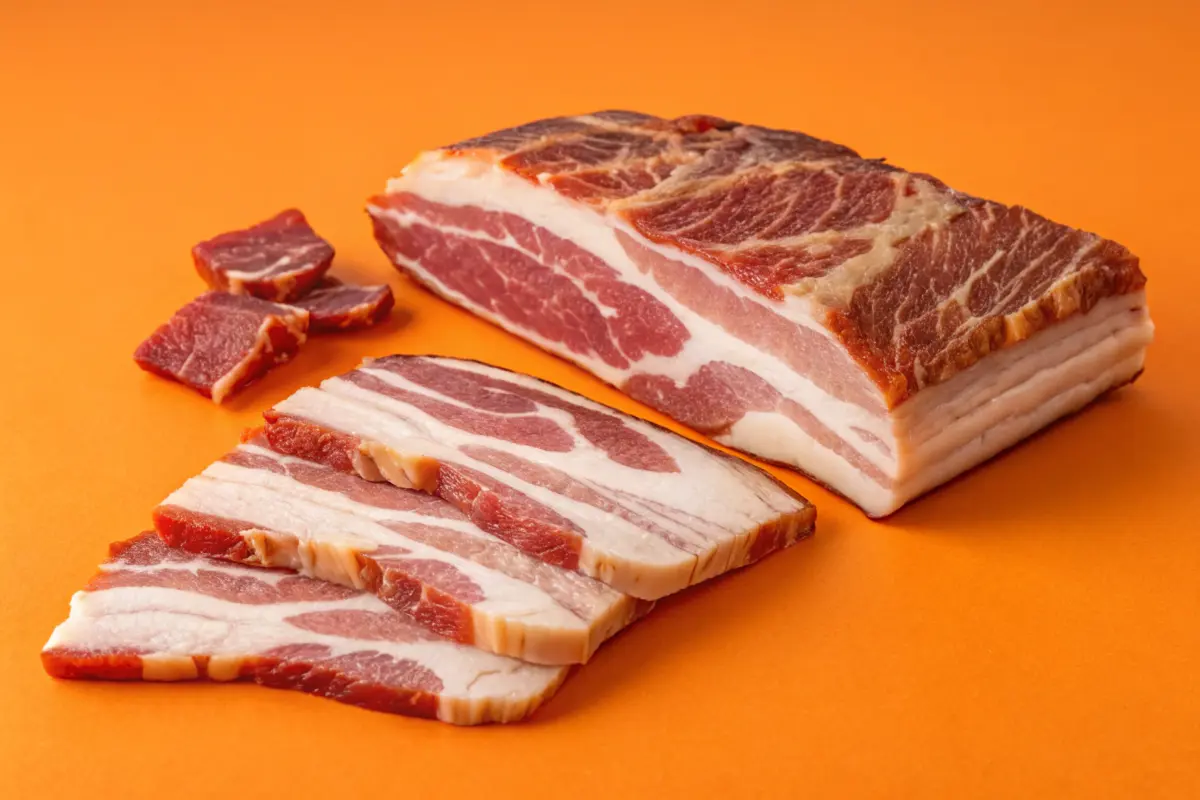
2 thoughts on “Beef Bacon Uncovered: Irresistible Flavor, Surprising Benefits, and Must-Know Cooking Secrets”